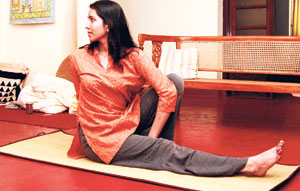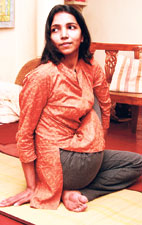Her healthy glow makes it difficult to believe that for the past three days, Yogacharini Maitreyi has had nothing to eat or drink save a little tender coconut water. Before that it was only fruit for two days, and that is all she will eat again today and tomorrow. Only then, after seven days, will her cleansing ritual come to an end, marking a return to a normal diet. Despite this, she adheres to routine. Awake by 5:30 a.m. she meditates for half an hour, before beginning her hour and a half of daily yoga. Her self-discipline varies little with the season – it has grounded Maitreyi for most of her life and continues to serve her well.
 |
At 34, Maitreyi is a rising star in yoga circles. She is one of the youngest women ever to sit on the Advisory Board of the World Yoga Council and was awarded the title of Yoga Chemmal (expert) in India in 2007. As the founder of the Arkaya Trust (www.arkaya.net), she has worked with monks in Sri Lanka, children in Indian slums and prisoners in Sweden, pausing along the way to teach in Bangladesh, Vancouver and several European cities. Teaching yoga is Maitreyi’s passion and a profession that she has pursued for over a decade.
Her own studies began early. “I’ve been practising ever since I can remember,” she says, adding, “My grandfather was my first guru.” Over daily conversations and sittings with him, a young Maitreyi learnt not only the basics of yogic jathis, kriyas, asanas and pranayamas but also the philosophy and attitudes that continue to be at the heart of her practice. As a result, her grandfather is always mentioned before the other, more celebrated gurus she has studied under.
“Yoga is shakthi (power) through bhakthi (devotion to the divine),” says Maitreyi. The term comes from the root word “yuj” meaning to yoke, to bind, to bring together.
“In essence, yoga is bringing together our individual consciousness with the supreme consciousness,” she elaborates, explaining that for those who do not believe in God, one’s own unrealised potential is substituted for that of the supreme consciousness. “We all have the potential to be divine, we have the potential for compassion, for unconditional love but we haven’t tapped into it,” she tells me. One must begin by bringing body and mind into harmony – “even within ourselves we are fragmented,” she says in the context of internal conflict and emotional pain. “How do we resolve that? That basic mindfulness is also taught in the yogic process.”
 |
When practised properly, yoga offers more than physical exercise it conditions your emotions. Maitreyi helps her pupils understand the profound connection between their breathing and their emotional state and during a session, breathing practices are carried out in alignment with the exercises. Deep cleansing breaths, the chanting of simple mantras and even simpler movements are all used to build a sturdy foundation that helps novices transcend the daily grind. Regular sessions help practitioners respond appropriately to conflict, manage emotional and professional upheaval, bolster their health and even cope with small stresses like road rage and stage fright.
But it is when it comes to battling chronic disease particularly, that you realise that yoga is a lifestyle. You wake up early and sleep early, you practise regularly, you cultivate peace of mind, and you eat carefully. “When you look at it holistically, it is just common sense,” says Maitreyi outlining some of the basics of a yogic lifestyle. Diet is key, and is heavy on sattvik elements.
“These are foods that have prana (energy) or give you prana,” she says using fruits and sprouted grains as an example. “The sattvik nature comes to the food with how a plant is grown and how an animal is treated,” she says, advising against processed and packaged foods. Heavy ‘Tamasik’ foods like red meat and alcohol are to be avoided while ‘Rajasik’ foods are stimulants, and only a few like spices and onions can be taken in moderation.
It’s not only about what you eat, but when you eat and how you eat. “Ideally you should drink your food and chew your water – chew your food so much that you’re able to drink it and keep the water in your mouth like you’re chewing it. You eat slowly, you eat in silence, you eat enjoying the food, allowing it to nourish you. Try and eat before sundown.”
Yoga’s philosophy can be a lot more complex, and requires deep meditation before an individual practitioner is able to apply it in real life. Speaking of the ten yamas or codes of conduct, Maitreyi says, “each of the yamas takes a lot of contemplation; it takes a lot of application in real life.” Speaking of ahimsa, she says, “for example, I don’t want to hurt anybody but I am allowing someone who is unaware to step on my toes. How do we set loving boundaries?” It might take time and patience, but Yoga has some of the answers. “There are no short cuts,” says Maitreyi.
Though Maitreyi seems completely immersed in her chosen lifestyle, she was once a student of visual communication and ran her own advertising production house.
Still, she had already begun teaching yoga at that point. Despite her success with the former, “I realised I couldn’t manage both and so I had to take a decision to go deeper into one thing,” she says adding that she dabbles in spurts but that her writing (she is currently a columnist for The Hindu) and film making skills are now focused on promoting yoga.
In fact she’s so determined to spread the word, that in her home town of Chennai, the Akarya Trust began venturing into a place few of the city’s middle class would set foot in – a slum which was the territory of the late Veeramani, a mafia “don” who inspired much trepidation at that time.
When volunteers balked, Maitreyi offered some practical reassurance, “see they’re (the don’s henchmen) not going to hurt you unless they’ve been paid to hurt you and nobody has hired them so they won’t do anything.”
It took time for mutual trust to build between the teachers and the community, but today the organisation teaches 20 young people yoga and has begun initiatives to clean up the slums and inculcate basic hygiene in the children.
Having just looked in on her young protégés, Maitreyi is in Sri Lanka on a brief visit. She will return again, as is her habit, next year to teach. She says it is this that sustains her teaching –her growing community of pupils who year by year, reaffirm her faith in yoga’s endless power to heal and empower. |
